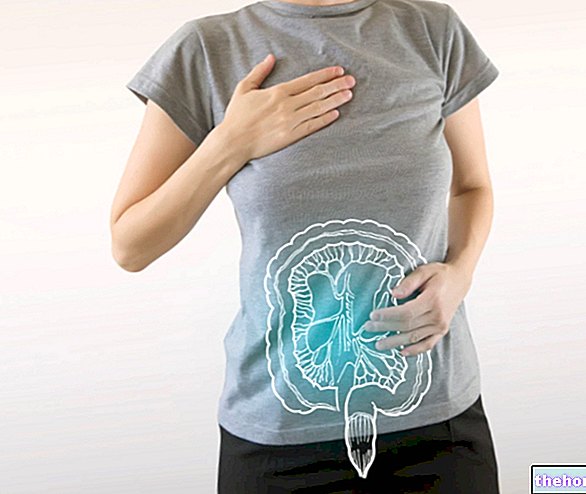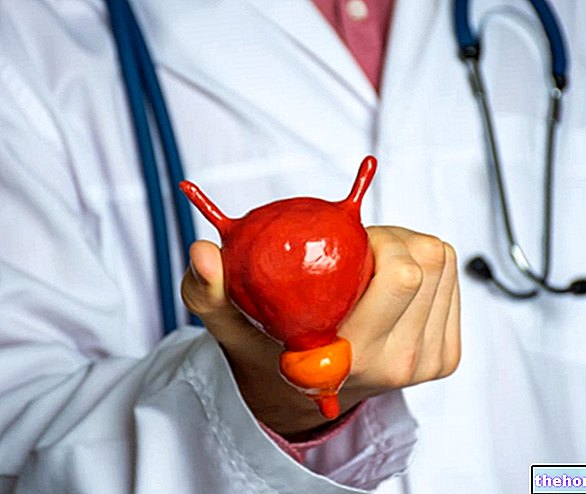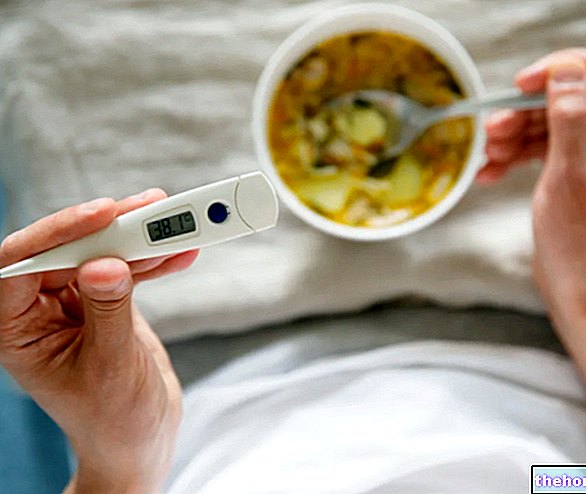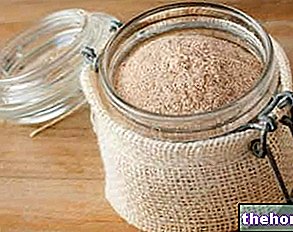Both fever and hyperthermia cause the body to overheat, but through two totally different pathogenetic mechanisms:

- Fever is triggered by chemical damage by cytokines (chemical mediators) on the hypothalamic central regulation "thermostat", which in turn generates excessive heating;
- Hyperthermia is generated by the imbalance between thermogenesis (production of body heat) or external heating (such as solar irradiation) and the thermal dispersion system (cutaneous vasodilation, sweating, etc.) which results in a progressive accumulation of heat.
Note: treating fever and reducing pyrexia do not always follow the same treatment process; in case of temperature alteration it is first of all fundamental to identify (if possible) the etiopathological agent (ie the cause: inflammation, viral infection, burn etc.) responsible for the body alteration, then eliminate it. The use of antipyretic drugs (such as paracetamol) is useful for reducing the pyretic symptoms of fever but is NOT an effective cure. Obviously, if it is not possible or essential to intervene on the primary cause of the fever, antipyretics represent the only intervention. applicable pharmacological.
only in the case in which it exceeds the limit of tolerance of the subject.From the metabolic point of view, fever significantly increases the energy expenditure measurable through the consumption of basal oxygen; the estimates made on the general population indicate that for each degree centigrade (° C) above 37, the body needs 13% more oxygen to meet the needs of all physiological and para-physiological processes. This means that, with the same amount of energy introduced with the diet, fever (by increasing the oxidative energy processes) can favor the reduction of the reserve energy substrates (fat and glycogen), consequently also decreasing body weight; having said that, it might seem obvious that in the presence of fever it is essential to modify the diet by increasing the energy intake to cover the minimum requirement for maintaining body weight; for example:
Assuming that the subject "X" normally has an energy expenditure of 2000kcal, in the event of a fever at 39 ° C (2 ° C above the threshold of 37 ° C) he would need a caloric surplus of 26% (13% multiplied by the 2 ° C), or 520kcal. On balance, subject "X" should correct their diet by increasing their caloric intake as follows:
- 2000kcal + 520kcal = 2520kcal
NB. It is advisable to maintain a normal protein intake and proportionally increase both lipids and carbohydrates.
In the event that the subject "X" maintains an energy intake of 2000kcal and the fever at 39 ° C is constant for 14 days, the algebraic sum between the calories introduced with the diet and the calories burned in the presence of fever would be NEGATIVE giving rise to weight loss:
- [(2000 * 14) - (2520 * 14)] = (28000-35280) = -7280kcal
Furthermore, knowing that PHYSIOLOGICALLY to eliminate 1 kg of fat it is necessary to burn about 7000kcal, it is possible to state that the subject "x", during 14 days of fever at 39 ° C in which he did NOT follow an adequate diet, could suffer a weight loss about 1kg.
Obviously, this example DOES NOT take into consideration the presence of many variables (FOR EXAMPLE THE REDUCTION OF THE PHYSICAL ACTIVITY LEVEL) that contribute to determining the final energy balance, therefore it must be considered as an absolute SIMPLIFICATION.
NB. If the reader is seduced by the possibility of facilitating weight loss NOT by treating fever or the causative agent that generates it, we remind you that the increase in expenditure associated with bed rest or immobilization of the patient determines a NON-selective weight loss which negatively affects both on the trophism of muscle mass and on the consistency of hepatic and muscle glycogen reserves.
To get a more realistic picture of the metabolic impact of fever on the body, the following key points should also be taken into consideration:
- Dehydration: fever generates an increase in body temperature which often requires greater heat dispersion, thus leading to an increase in sweating; therefore, if the diet does not contain sufficient water, the reduction in body weight may indicate more general dehydration than a depletion of energy reserves. It follows that the diet for fever MUST first of all guarantee the basal water requirement, compensate for sweating and facilitate the renal drainage of any pharmacological catabolites
- The "increase in the basic energy expenditure is compensated by the physical" INACTIVITY "of the subject: it is appropriate to consider that (usually) the fever does NOT allow the carrying out of common work, recreational and sports activities; considering that the energy expenditure of a stationary subject in bed is almost comparable to his basal metabolic rate (MB) while the Physical Activity Level (LAF) fluctuates between + 33% and 110% more than the same basal metabolic rate, it is possible to say that normally the diet for fever of A BED OR SICK SUBJECT should bring an energy quantity LOWER than that normally introduced with the diet DESPITE the fever generates a basal increase of 13% every 1 ° C. For example, for subject "Y" who has a basal metabolic rate of 1300kcal and a Physical Activity Level that increases energy expenditure by 55%, FOR A TOTAL OF 2015KCAL, stay in bed with a 2 ° C fever (+ 26% of calories) would mean having a total expenditure of 1638kcal ... WELL 377kcal less than normal!
- Vomiting and malabsorption linked to the morbid condition: in the event that the causative agent is a pathogen (virus, bacteria, protozoa or other parasites), or a "poisoning by ethyl alcohol or other nerves, and the fever is accompanied by vomiting and diarrhea, the diet must undergo drastic changes. First of all, remember that vomiting and diarrhea cause accelerated dehydration, therefore, the reduction in body weight is mainly related to the volume deficit (volume) of the blood plasma; secondly, the inability to retain food in the stomach or the decrease in intestinal absorption reduce (sometimes severely) the amount of energy and essential elements introduced by the diet. Therefore, in addition to a state of transient general malnutrition, there is a degradation of the reserve energy substrates as well as of muscle tissue (favored by the immobility of the patient) found in indiscriminate weight loss (both lean and fat mass).In this case, the fever diet should favor the gastric passage without inducing vomiting and prepare for proper digestion and absorption; in this regard, it is very useful to make use of moderately protein foods with a higher content of carbohydrates and vegetable oils (semolina enriched with pureed legumes and seasoned with extra virgin olive oil and a little grated cheese), easily digestible (simple and not prolonged cooking) , favor semi-liquid foods (NOT totally liquid, because the digestive tract can react to the sense of fullness with the urge to vomit), with moderate and rather frequent portions; moreover, it would be better to AVOID foods that contain nutrients that are difficult to tolerate such as lactose.
- Transient anorexia: from a behavioral point of view, patients suffering from fever do not feel the need (or the physiological stimulus) to eat and drink. If the fever diet is not drawn up and followed carefully, in addition to the risk of malnutrition, by reducing the water supply, both the potential for heat dispersion and the renal filtration capacity are worsened; with regard to the latter, on the contrary, it should be encouraged thus facilitating the elimination of endogenous and pharmacological catabolites.
The diet in fever must take all these factors into consideration in order to optimize the healing process and avoid any side effects related to malnutrition; it is advisable to pay particular attention to the water, salt and vitamin intake but not to neglect (if possible) also the intake of foods containing the other essential molecules (omega 3 fatty acids and amino acids deriving from proteins with a high biological value).
it is possible to resort to special rehydrating and alkalizing formulations, based on sodium and / or potassium citrate (eg bioketase). In case of prolonged vomiting, rehydration can also take place intravenously.
- in case of prolonged therapy with corticosteroids it is necessary to limit the sodium intake with the diet and increase that of potassium, since these drugs determine sodium retention and increase the excretion of potassium
- in case of fever associated with diarrhea, dairy products and sugary foods (sweets, jams) should be avoided, as they could aggravate the condition due to osmotic reasons. Among the fruit juices - foods notoriously useful for the hydrosaline and vitamin rebalancing - those without added sugars, or better still those prepared at home, should be preferred, given that sweeteners with a marked laxative effect are sometimes added instead of sugar in industrial products (for example for example polyols: sorbitol, mannitol, xylitol and others).
- dairy products must be taken at least 3-4 hours after the oral administration of tetracyclines, since they could inactivate the drug by precipitation in the intestine
- in case of fever associated with severe hepatitis, the diet should be low protein




























